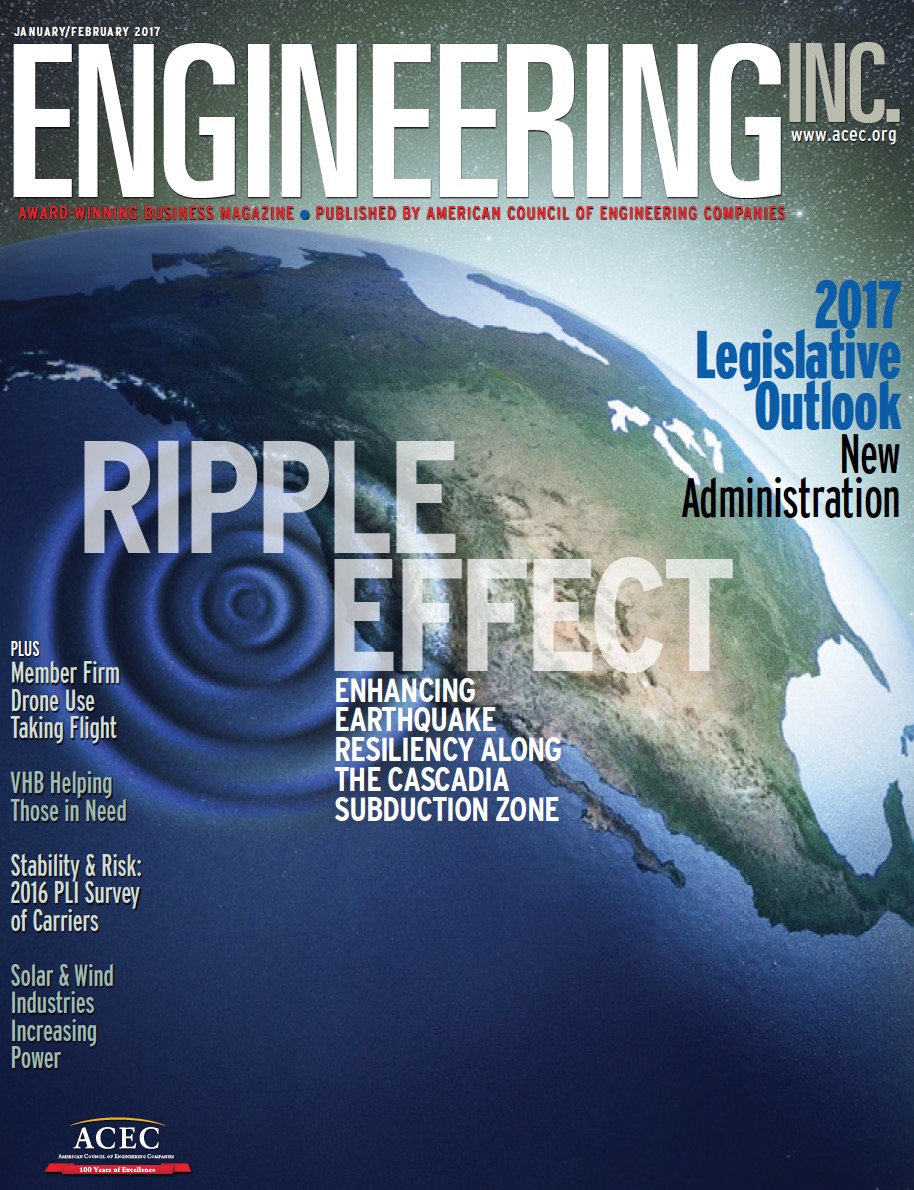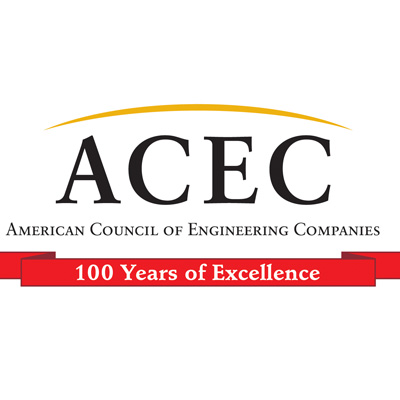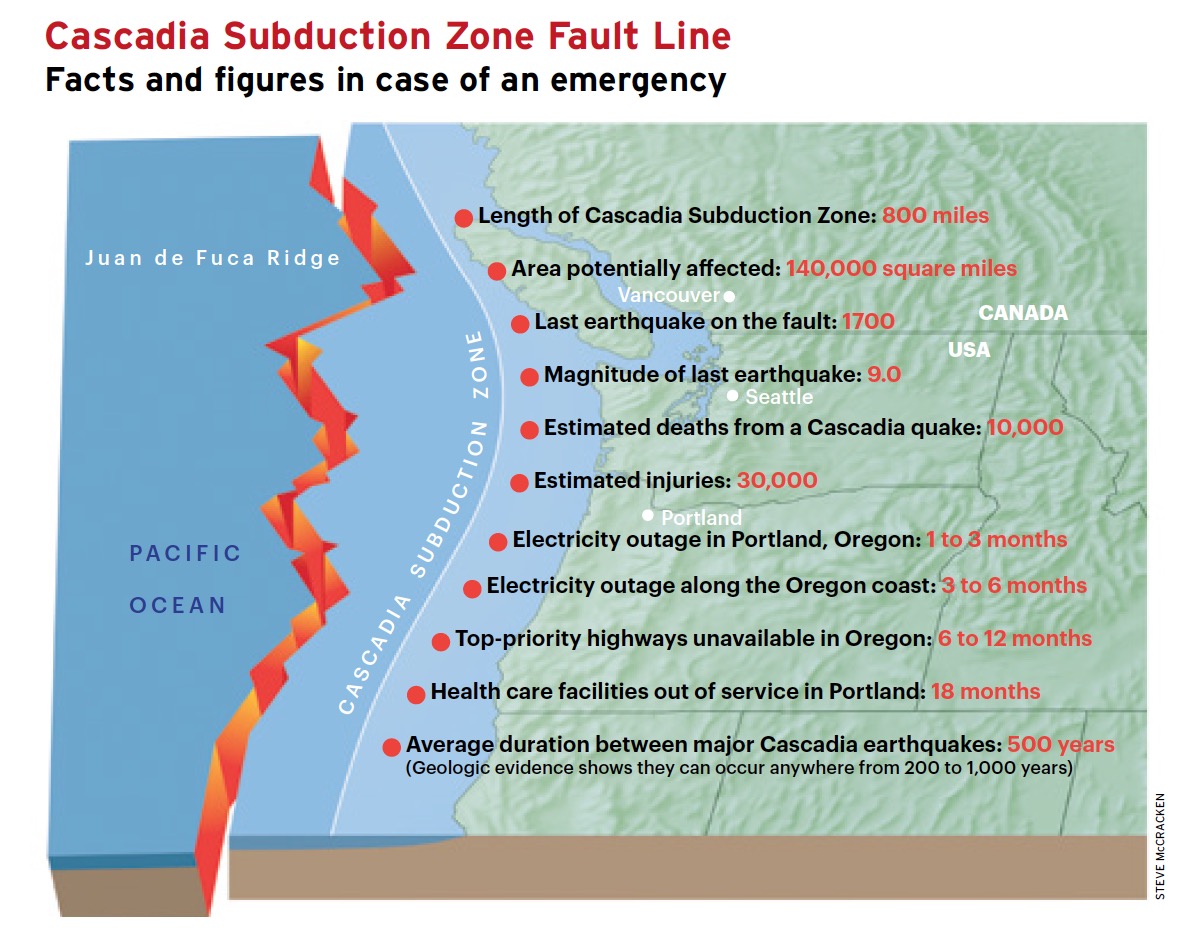AMERICAN COUNCIL OF ENGINEERING COMPANIES (ACEC)
In the Crosshairs: the Pacific Northwest lies within one of the most dangerous seismic zones in the world. The risks are enormous, but public officials and engineers are scrambling to enhance the region’s earthquake resiliency
By Samuel Greengard
 An earthquake powerful enough to collapse buildings and bridges, snap power lines and gas pipes, and cause major fires may sound like the theme of a summer blockbuster movie, but it’s a very real risk to residents in the Pacific Northwest.
An earthquake powerful enough to collapse buildings and bridges, snap power lines and gas pipes, and cause major fires may sound like the theme of a summer blockbuster movie, but it’s a very real risk to residents in the Pacific Northwest.
While the Golden State has endured several major quakes over the last half century, the dangers of seismic destruction also extend north to Oregon and Washington. In fact, the region—which is part of the geologic formation called the Cascadia Subduction Zone—could see far more violent and destructive seismic events than anything experienced in California.
Experts say an earthquake in the Pacific Northwest could exceed a magnitude of 9.0 and last for three to five minutes. It could also unleash a tsunami that would devastate the coast and possibly wash entire towns away. The resulting damage could leave the region in shambles for years.
“If a magnitude 9 or above earthquake shakes for up to five minutes and causes a tsunami, it will be a devastating event,” says Kenneth Murphy, Federal Emergency Management Agency (FEMA) administrator for the region and former emergency management director for the state of Oregon.
According to Murphy, a Cascadia Subduction Zone earthquake could impact 140,000 square miles and “have farther reaching impacts than that of Katrina and Sandy combined.” In fact, FEMA predicts it would be the worst natural disaster in U.S. history.
To handle this threat, public officials are devising contingency plans and engaging in emergency response drills, and architects and engineers are designing new and innovative buildings and bridges that take seismic safety into the future.
“We are learning from every earthquake,” says Stacy Bartoletti, CEO and chairman of structural engineering firm Degenkolb Engineers. “We are introducing new materials, new designs and improved engineering techniques that make structures more earthquake and tsunami resilient.”
Fault Tolerance
Although fault lines and earthquakes occur almost everywhere in the world, the Cascadia Subduction Zone, an 800-mile fault line that runs from Northern California to Vancouver, British Columbia, is particularly threatening. Seismic events, including earthquakes, occur less frequently there than in California (typically a few hundred years versus decades or approximately a century), but this type of geology produces far more devastating effects.
As one continental plate is pushed underneath another, deep earthquakes, volcanoes and tsunamis result. Making matters worse, a Cascadia subduction earthquake isn’t the only risk. Other faults lie in the region. For example, the Seattle metro area, with a population of approximately 3.5 million, is built atop a fault appropriately named the Seattle Fault that could generate a 7.5 earthquake.
“These can be among the most violent events on the planet,” says Chris D. Poland, founder of Chris D. Poland Consulting Engineer, who specializes in seismic issues.
The problem? Much of the infrastructure of the Pacific Northwest is not equipped to withstand violent shaking or an ocean wave that could reach 30 or 40 feet high and surge inland.
Liquefaction is also a serious threat. Most of the major cities in the region enacted seismic building codes in the 1980s, says Ron Hamburger, senior principal at the structural engineering firm Simpson Gumpertz & Heger.
“The principal concern is with older buildings that were constructed in the 1970s or earlier,” he says. “These structures were not necessarily designed to a reliable building code. Many of them have seismic vulnerabilities.”
Similarly, many highway and river bridges do not meet modern seismic standards, including the American Association of State Highway and Transportation Officials codes adopted in the 1990s. Underground oil and gas lines would also likely sustain a great deal of damage. Yet, a tsunami might be even more devastating than the earthquake that caused it. Within Washington and Oregon, hundreds of thousands of residents and potential visitors are, at any given moment, located in low-lying areas vulnerable to a giant wave and surge. This includes senior facilities and schools where there is virtually no escape path from a tsunami that comes without warning. While a Pacific tsunami warning system exists, a quake in the Cascadia Zone would occur within the boundary of the system, which means it wouldn’t be detectable.
According to FEMA, more than 10,000 could die in a Cascadia earthquake and tsunami, and 30,000 could be injured. Upward of 1 million people would need shelter, and 2.5 million would require food and water, FEMA estimates. Simply put, much of the region would be reduced to rubble, and coastal areas could become uninhabitable for years. FEMA estimates the damage could be in excess of $70 billion.
The danger extends beyond the initial seismic event. “The issue isn’t only public safety and people losing their lives or being injured; it’s also about the long-term economy of the region. The reality is that widespread damage could impact the region for months or years,” Bartoletti says.
In the end, the Pacific Northwest could see a long-term exodus of population and businesses. It could become economically depressed similar to New Orleans, which has yet to completely recover from Hurricane Katrina.
Shaking Things Up
There have been some positive advancements, however. In September 2016, for example, the American Society of Civil Engineers introduced a set of standards, which focuses on hazards resulting from earthquakes, tsunamis and other natural occurrences.
The tsunami standards pertain to steel-reinforced concrete buildings in “inundation zones.” The goal is to build stronger and safer structures with only a moderate increase in cost. The initiative also establishes guidelines for applying U.S. Geological Survey hazard data to building structures, including bridges.
Engineering firms are putting those standards into practice in the Pacific Northwest. They’re using computer models, simulations and other tools to better understand ground motions and how structures react in shaking, liquefaction and tsunami situations. In September 2015, T.Y. Lin International and HNTB completed construction on the 2016 EEA Honor Award-winning Tilikum Crossing, Bridge of the People, a 1,720-foot-long cable-stayed design over the Willamette River in Portland, Oregon.
The $135 million project, which carries transit and pedestrian traffic, is built to withstand a major seismic event, such as a 9.0 earthquake along the Cascadia Subduction Zone. At the cutting edge of design and engineering, the Tilikum Crossing incorporates two 160-foot pylons with supporting drilled shafts and pylon caps that were designed for non-linear soil-structure interaction in an extreme earthquake.
“Liquefaction and lateral spreading were significant factors for design,” says David Goodyear, chief bridge engineer for T.Y. Lin International. “In an earthquake, the approach rail bed would likely be more affected by liquefaction than the bridge.”
But bridges and roadways aren’t the only structures needing upgrades—everyday facilities, such as schools and hospitals, are getting safety enhancements. At Ocosta Elementary School in Westport, Washington, Degenkolb Engineers designed an elevated gymnasium structure to withstand tsunami-induced hydrostatic, hydrodynamic, scour and impact forces through various engineering methods. The pile foundations are designed to resist liquefaction; concrete shear walls resist seismic and inundation forces; and structural steel gravity columns resist expected impact loads.
In addition, the design incorporated moment-resisting beam column connections that provide alternate path progressive collapse resistance. The structure, which was completed in 2016 for $13 million, is the first tsunami vertical evacuation structure in the U.S. “There were critical considerations revolving around the height of the wave and designing a structure that could withstand the impact of floating debris,” Bartoletti says.
However, a new bridge or an occasional tsunami shelter, though important and innovative, cannot address the broader issue of replacing or upgrading existing infrastructure that doesn’t meet earthquake safety standards. Although some large companies such as Intel and Boeing have spent millions to retrofit buildings in the region, other facilities, such as schools, hospitals and prisons, are mostly lagging behind. In addition, rail systems and other transportation networks, particularly along the critical I-5 corridor, aren’t designed to withstand a quake—and many systems would be rendered unusable for weeks or months afterward.
Download full article (PDF): In the Crosshairs
Download January/February 2017 issue of Engineering, Inc.
 About the American Council of Engineering Companies
About the American Council of Engineering Companies
www.acec.org
The American Council of Engineering Companies (ACEC) is the voice of America’s engineering industry. Council members – numbering more than 5,000 firms representing more than 500,000 employees throughout the country – are engaged in a wide range of engineering works that propel the nation’s economy, and enhance and safeguard America’s quality of life. These works allow Americans to drink clean water, enjoy a healthy life, take advantage of new technologies, and travel safely and efficiently. The Council’s mission is to contribute to America’s prosperity and welfare by advancing the business interests of member firms.
Tags: ACEC, American Council of Engineering Companies, CA, California, Cascadia Subduction Zone, earthquakes, Emergency, Engineering Inc., Resiliency







 RSS Feed
RSS Feed